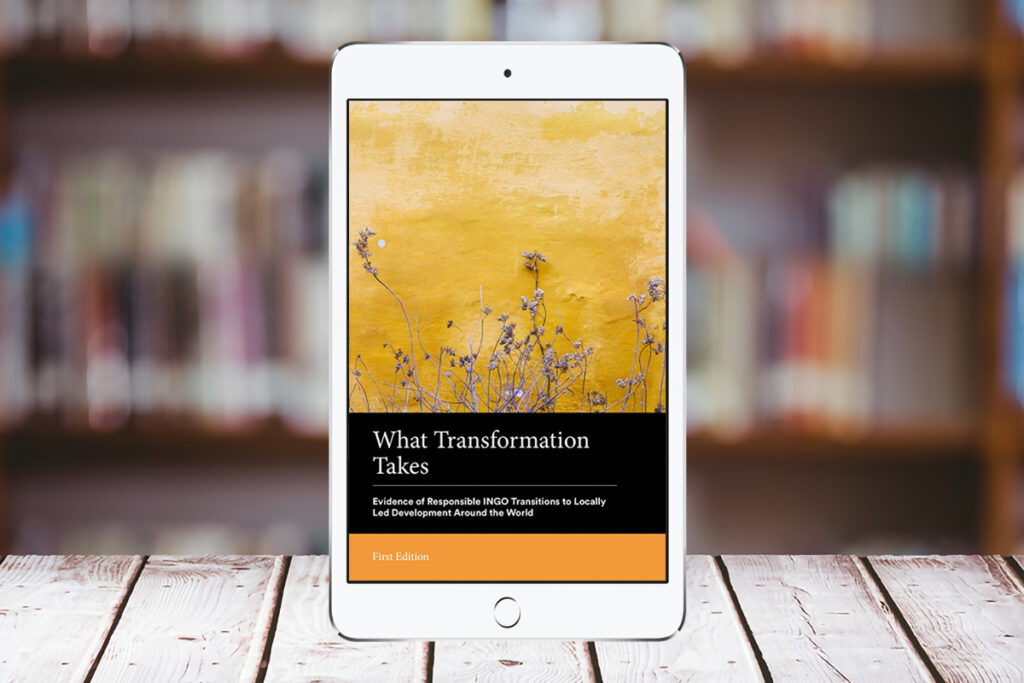In this review, I share an overview of What Transformation Takes and those case studies that I found most spoke to the need to reimagine development work to be more locally led, with evidence in mind. I also share my view on the project’s limitations.
For an impact organization, success means working yourself out of a job. This includes withdrawing from programs in a manner that sets the stage for communities’ future success. While international nongovernmental organizations (INGOs) regularly exit programs and transition work to communities, there is an open question of how responsible these transitions tend to be.
Stopping as Success (SAS) is a collaborative learning project focusing on how to make INGO transitions more responsible. At the project’s core is a collection of case studies of responsible transitions, which SAS compiled in their book, What Transformation Takes: Evidence of Responsible INGO Transitions to Locally Led Development Around the World. In addition to the case studies, the project also includes several resources online to help elevate the conversation about responsible transitions.
In this review, I share an overview of the book and those case studies that I found most spoke to the need to reimagine development work to be more locally led, with evidence in mind. I also share my view on the project’s limitations, including the need for a more nuanced discussion of how to define transition and what it means for transitions to be successful.
Overview: Positive deviance approach
The book has five thematic sections—partnerships, capacity development, leaders and champions, financial sustainability, and communicating—while emphasizing the overarching theme of power and legitimacy.
SAS describes their project as following a positive deviance approach: examining successful transitions, what can we learn about what went right and why? The authors aim for the studies to “help define the contours of what is possible related to shifting power, and where more attention and expertise is needed in the wider sector to advance that vision” (Page 14). While they generally let the 19 case studies speak for themselves, the authors offer high-level takeaways. The introduction presents eight overall lessons, like “Smaller, more flexible funding sources and other types of resource transfer are invaluable for successful transitions.” The book has five thematic sections—partnerships, capacity development, leaders and champions, financial sustainability, and communicating—while emphasizing the overarching theme of power and legitimacy
The case studies in What Transformation Takes are detailed, practical examples of how INGOs and local or national organizations collaboratively transitioned “responsibility, ownership, resources, and power” (Page 385) towards the communities served. Each study centers on interviews with a variety of project stakeholders and explains when and how information was collected. The first several pages of each study introduce the country context, including political and economic situation, foreign assistance trends, and civil society environment. The studies are heterogeneous in content and structure; the stories unfold across sections like “Triggers for Transition,” “Key Success Factors for Transition,” and “Challenges.” Each concludes with “Key Lessons” about what went well and what we can learn from that success.
The authors note that their case studies are not a representative sample of all INGO transitions. Indeed, the portfolio largely focuses on civil society and peacebuilding, as well as INGO country offices. While they describe that case study selection was based on diversity of geography, sector, and type of transition, transitions of INGO offices account for six of the 19 case studies and across the collection, only one case falls directly in the health sector.
Highlighting two case studies: Tuungane and Nuru Kenya
I would not expect that every reader would sit down to read the book’s 400 pages cover to cover as I did. If you’re only going to read a couple of the case studies, I recommend the Tuungane (Chapter 18) and Nuru Kenya (Chapter 15) case studies.
In addition to reporting interview findings, the researchers summarize the evidence base on community-driven reconstruction and development, as well as findings from Tuungane’s reviews and evaluations.
The study of Tuungane program’s transition from International Rescue Committee (IRC) to local stakeholders in the Democratic Republic of Congo struck me as the most rigorous in documenting evidence. A quarter of the mentions of the word “evidence” in What Transformation Takes occur within this chapter. Tuungane was a community-based reconstruction and development initiative. When IRC learned that funding was coming to a close, they reimagined the last phase of the project to increase focus on social accountability and work within local power structures. In addition to reporting interview findings, the researchers summarize the evidence base on community-driven reconstruction and development, as well as findings from Tuungane’s reviews and evaluations. They find that the first phase of the program, focused on service delivery, appeared to have few downstream socioeconomic effects. However, the shift in emphasis to broader accountability dynamics in the second phase seemed to result in improvements in measures of social accountability. Many of the case studies do not mention impact assessments, so this discussion was refreshing.
I found Nuru Kenya’s case study to be especially candid about challenges the team faced when redefining the typical relationship between development actors and local stakeholders.
I found Nuru Kenya’s case study to be especially candid about challenges the team faced when redefining the typical relationship between development actors and local stakeholders. Nuru International co-created a food security program alongside community members, intending from the start that international staff would ultimately exit. Nuru Kenya leaders shared that community members’ previous experiences with development actors made them skeptical of a program that incorporated local leadership as theirs did. One Kenyan leader commented, using the term muzungu referring to a white person, “When Nuru International exited, it took time for [Nuru Kenya staff] who remained to try to create awareness, teach farmers why muzungu exited, why we are changing our strategy… When a program comes with muzungu intentions, or muzungu initiatives, it can be hard to implement” (Page 316). A mindset shift was also needed among international staff. During a climate event, one Nuru International staff member struggled to overcome the urge to redirect resources to providing aid rather than continuing to focus on facilitating ownership from community members, per the project’s scope: “Do we want to quickly help them bounce back so that we don’t lose ground gained, or be more consistent with the fact that we don’t do [humanitarian response]?” (Page 317). I appreciated the researchers venturing into this delicate territory.
Limitations: defining success and transition
What Transformation Takes also aspires to be more than just a collection of case studies.
As a collection of INGO transition case studies, the book prompts a conversation about INGO roles in locally led development and provides detailed examples that could guide practitioners in similar situations. In this respect, for me, as someone newer to my career in development, I found the book educational about different country contexts and ways some projects approach uplifting local leadership.
What Transformation Takes also aspires to be more than just a collection of case studies. The positive deviance approach is intended to facilitate learning about drivers of transition success and suggest where practitioners in the sector should direct attention and expertise. In this regard, I closed the book dissatisfied with how it lived up to its aspiration.
The authors do not engage in a nuanced discussion about how we might define what success means for a transition, as well as how we should define transition at all. I consider both ideas fundamental to learning about transitions and starting a conversation about where to direct the industry’s attention and expertise.
Need for a nuanced definition of success
Considering some of the cases as positive outliers felt like glossing over the challenges faced and what we can learn from them.
It is challenging to determine whether the case studies represent positive deviance because some of the cases did not strike me as strong success stories. The studies come across as objective and nuanced; each presenting a complex picture of a transition, where some factors enable power shift and others pose meaningful challenges to sustainability. However, the book’s positive deviance frame invites us to read them all as success stories. Considering some of the cases as positive outliers felt like glossing over the challenges faced and what we can learn from them. Two pertinent examples come from BRIDGE (Chapter 12) and the Iloilo City TB Taskforce Federation (Chapter 5).
While some case studies shared clear positive outcomes, others did not have a happy ending to report. For example, BRIDGE’s “financial situation is not healthy” and the team “had to let many professional people go” so that when interviewed they only had six staff members, including the founders and board. The authors placed this case study under the financial sustainability theme. The introduction to this theme notes that when INGO transitions are motivated by declining funding – as was true in this case—the local entity often faces the same challenges. BRIDGE’s story is an appropriate example of this challenge and how it can lead to detrimental outcomes for organizations.
While it’s encouraging to see that the volunteers’ donated time and resources contributed to a successful outcome, I struggle to see this example as one that should be emulated by other INGOs.
In the case of the Iloilo City TB Taskforce Federation, success seem to have come at costs for local staff. The federation has become an “active and crucial actor in the city’s health sector” since an ordinance integrated it into the public health system. However, while the ordinance was enacted in 2011, funding was only made available five years later. Before their exit in 2011, World Vision, the federation’s founder, donated $1,300 to a microcredit fund with the intention of supporting the federation after funding ceased. However, the intermediary mismanaged the funds so that they were no longer available for use. In lieu of financing, federation “volunteers—most of whom also come from resource-poor backgrounds – continued working, spending their own money on house-to-house trips and accompanying clients to clinics” (Page 140). While it’s encouraging to see that the volunteers’ donated time and resources contributed to a successful outcome, I struggle to see this example as one that should be emulated by other INGOs.
It’s worth emphasizing that SAS’s assessment of whether a project was successful and thus eligible to be included in the project was a “positive outcome as defined by local communities” (Page 14). In both cases, the local teams’ accomplishments should certainly not be understated, and it is clear that their ongoing work generates positive consequences that would not have occurred without their efforts and partnership from the INGO involved. At the same time, categorizing the case studies as examples of positive deviance is a step beyond this benchmark, and it feels like an awkward fit. Interviewees in both case studies suggest specific ideas for how INGO involvement could have smoothed over transition challenges and thus facilitated a stronger local organization at present.
Focusing only on positive takeaways seems like glossing over the important lessons this set of case studies has to offer about how actors did and did not surmount transition challenges.
The book does not aim to compare the effectiveness of specific transition approaches or models; it highlights lessons learned about positive aspects in each case. But focusing only on positive takeaways seems like glossing over the important lessons this set of case studies has to offer about how actors did and did not surmount transition challenges. Overall, I would have liked to see a more nuanced framework for learning from the case studies.
Need for structured definition of transition
Without a discussion of what we mean by transition, it is difficult to engage thoughtfully with the overarching question of what responsible behavior looks like for INGOs in transition.
SAS chose not to offer a definition of transition in the book. However, I consider a discussion of what transition means to be essential to benefiting from the text, especially because some case studies end with the local or national actor’s ongoing dependence on an INGO partner. Without a discussion of what we mean by transition, it is difficult to engage thoughtfully with the overarching question of what responsible behavior looks like for INGOs in transition.
I began the book with the notion that transition entails both separation between the international and local entities and the independent sustainability of the local entity. I found that SAS treats transition as more of an abstract concept about INGOs creating space for local leadership.
By my count, the majority of What Transition Takes case studies result in a significant ongoing relationship between the two actors involved. Further, I was surprised to find that the ongoing relationship between the entities often entails dependence on the part of the local or national organization. One such example is the transition of CARE International’s Burundi office to Great Lakes Inkingi Development (GLID), a Burundian organization (Chapter 3). CARE launched the transition based on strategic changes and financial constraints; they envisioned “using valued staff to carry forward its mission and values, setting up a local entity that could act as a privileged partner” (80). Six years after its transition in 2012, GLID was 95% funded by CARE International. An employee commented, “At this stage, if CARE goes out, GLID can’t continue” (Page 85).
The case study of Mennonite Central Committee (MCC) (Chapter 11) in India thoughtfully explores the idea of dependence. SAS indicated that they included this case in response to participant requests that the project include documentation of a sustained long-term partnership model. MCC implements projects through partnerships and small grants to local actors, with its mission “based on having a long-term presence” (Page 238). Asked whether the approach creates dependency, a representative drew the distinction between financial and technical dependence: “We have partners where if external funding stops, they won’t exist. But they are serving poor communities who will not have funding. There is no local funding” (Page 239).
By relegating this discussion to a footnote (with more context in a case study synthesis report online), SAS misses the opportunity to have a substantial conversation about these ideas and provide scaffolding for the reader to engage with them throughout the book. These examples invite a discussion about the appropriateness of INGOs departing or remaining involved with a local organization. In a footnote, SAS describes that its project title is something of a misnomer: “The case studies within this book show that the concept of ‘stopping’ (the ‘exit’ of an international partner) is a misrepresentation of the reality of transition processes” (Page 16). SAS describes that the ongoing relationships between both parties are complimentary and mutually supportive; though, oftentimes, “stopping” is in fact the sign of a successful partnership and avoids unnecessary international presence. By relegating this discussion to a footnote (with more context in a case study synthesis report online), SAS misses the opportunity to have a substantial conversation about these ideas and provide scaffolding for the reader to engage with them throughout the book.
The authors invite us to read the studies through the lens of themes about how transitions went well. But what about the nature of the transition themselves– the reasons they happened, the form of the resulting partnership, and the kind of roles INGO partners played? Discussing these ideas would help contextualize the case studies as a starting point for a broader conversation. The studies provide a wealth of practical detail about transition processes, but the book provides little space to step back and reflect on what to make of them. What is transition, if Nuru Kenya, Tuungane, GLID, and MCC all count? What should INGOs learn from them, especially if their sectors, partners, and business models are different than those in the studies?
It’s worth noting that in each of the above cases, except for Tuungane, the INGO plays an ongoing role of funder. Depending on their business model, many organizations’ unrestricted funds would not be sufficient to provide this type of support. Certainly, it would not be feasible for all the dozens of projects INGOs close each year. The number of case studies that rely on flexible or ongoing INGO support necessarily points to this complication.
Closing thoughts
A more nuanced discussion of what transition means and how it can occur in diverse contexts is necessary to shed light on what responsible INGO behavior looks like.
A more nuanced discussion of what transition means and how it can occur in diverse contexts is necessary to shed light on what responsible INGO behavior looks like, especially when it comes to the appropriateness of an ongoing presence.
Often, conversations about locally led development focus on change needed from funders rather than from INGOs. I appreciate that SAS’s compilation focuses specifically on lessons for INGOs and their partners, often with stories of transitions caused by changes in the funding landscape. I think these case studies have potential to inform and inspire, but in order for practitioners to utilize them meaningfully, they need to be framed in a way that allows the insights to shine through. Leaning into a nuanced representation of what success looks like and the different forms that transitions can take—especially highlighting different roles for INGOs—would benefit the project.
Sharing is caring!




